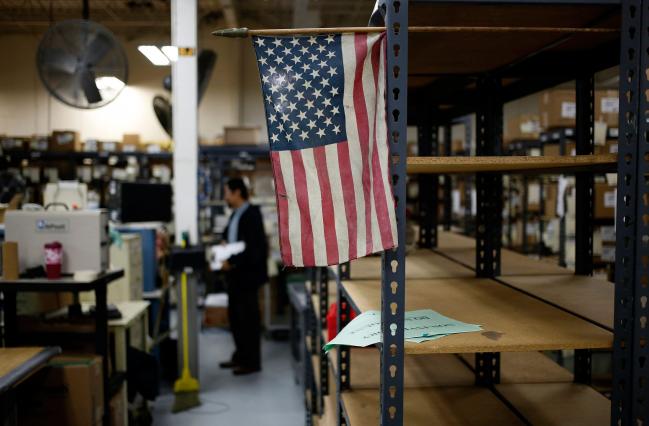(Bloomberg) -- Economists say the U.S. is entering a sharp recession, with some projecting gross domestic product is headed for its worst drop in quarterly records back to 1947.
Containing the outbreak has forced the world’s largest economy to a sudden stop, shuttering businesses that are in turn poised to cut millions of jobs. Gross domestic product estimates range widely, but most economists expect a severe second-quarter drop will be followed by a rebound in the second half of the year as the pandemic abates.
Meanwhile, almost 10 million Americans filed for unemployment insurance in the two weeks through March 28, equivalent to the total in the first 6 1/2 months of the 2007-09 recession. Many economists see the 3.5% jobless rate -- which in February matched a half-century low -- doubling or tripling in coming months.
Estimates, of course, are evolving quickly as the deadly path of the outbreak shifts by the hour, and some can soon be overtaken by events. Here are some of the latest, with GDP expressed as the quarterly change, seasonally adjusted annual rate:
Bank of America (NYSE:BAC) (April 2)
- GDP: -7% (Q1), -30% (Q2), -1% (3Q)
- Q2 unemployment rate: 15.6%
- “The recession appears to be deeper and more prolonged than we were led to believe just 14 days ago when we last updated our forecasts, not just in the U.S. but globally as well.”
Goldman Sachs (NYSE:GS) (March 31)
- GDP: -9% (Q1), -34% (Q2)
- Q2 unemployment rate: 13.2%, rising to 15% by midyear
- “While the uncertainty is substantial, we expect the lockdowns and social distancing to result in sharply lower new infections over the next month, and our baseline is that slower virus spread and adaptation by businesses and individuals should set the stage for a gradual recovery in output starting in May/June.”
Deutsche Bank (DE:DBKGn) (March 30)
- GDP: -2.2% (Q1), -33% (Q2)
- Q2 unemployment rate: 12%
- “The recovery in activity will not be V-shaped, however, and indeed we believe that the expected recovery in activity will be gradual as eradication of the virus remains uncertain for some time.”
NatWest Markets (March 30)
- GDP: -3% (Q1), -32.1% (Q2)
- Q2 unemployment rate: 12.9%
- “As we have said repeatedly, more important than the pace of contraction in Q2 is the speed and magnitude of the rebound in the second half of the year.”
JPMorgan Chase (NYSE:JPM) (March 25)
- GDP: -10% (Q1), -25% (Q2)
- Q2 unemployment rate: 8.5%
- “The economic effects are broadening from activities that lack social distance in consumption -- travel, theaters, etc. -- to those that lack social distance in production -- a much vaster swath of the economy.”
Wells Fargo (NYSE:WFC) (March 25)
- GDP: 1.2% (Q1), -14.7% (Q2)
- Q2 unemployment rate: 7.3%
- “There were less than 5,000 confirmed cases of Covid-19 in the U.S. at the beginning of last week. That number today exceeds 55,000, and it undoubtedly will shoot much higher in coming days and weeks.”
TD Securities (March 23)
- GDP: -3% (Q1), -25% (Q2)
- Q2 unemployment rate: 7.4%
- “The crisis is producing a dramatic policy response -- fiscal and monetary. Even so, a severe recession looks inevitable.”
Morgan Stanley (NYSE:MS) (March 22)
- GDP: -2.4% (Q1), -30.1% (Q2)
- Q2 unemployment rate: 12.8%
- “With disruptions to economic activity becoming greater, we now expect this contraction in economic activity to be even deeper.”
Bloomberg Economics (March 20)
- GDP: +0.5% (Q1), -9% (Q2)
- Q2 unemployment rate: 6.5%
- “The Covid-19 lockdown means a hard stop for the U.S. economy. The second quarter will bring a contraction rivaling the steepest in history, and surpassing the worst period of the financial crisis.”
- Link to note: GDP Facing 9% Contraction, Rivaling Worst Ever
Citigroup (NYSE:C) (March 20)
- GDP: -0.5% (Q1), -12% (Q2)
- Q2 unemployment rate: 6.4% (Q2)
- “Beneath the extreme Q2 slowdown/Q3 re-acceleration dynamics a moderate 2001-style recession to be playing out.”
Credit Suisse (SIX:CSGN) (March 20)
- GDP: -1.5% (Q1), -12% (Q2)
- Q2 unemployment rate: 8%
- “Economic data in the near future will be not just bad, but unrecognizable.”
UBS (March 20)
- GDP: -2.1% (Q1), -9.5% (Q2)
- Unemployment rate: 5.8% (Q2)
- “Demand will fall further as businesses halt travel, restaurants, bars, and theaters are shuttered, and schools in 35 of the 50 states are closed. All of April will be as weak as the second half of March.”
Oxford Economics (March 17)
- GDP: -0.5% (Q1), -11.9% (Q2)
- Unemployment rate: 10% (Q2)
- “The U.S. economy is in a recession. The coronavirus pandemic will lead to profound, pervasive, and persistent, but not permanent reductions in activity.”
©2020 Bloomberg L.P.
